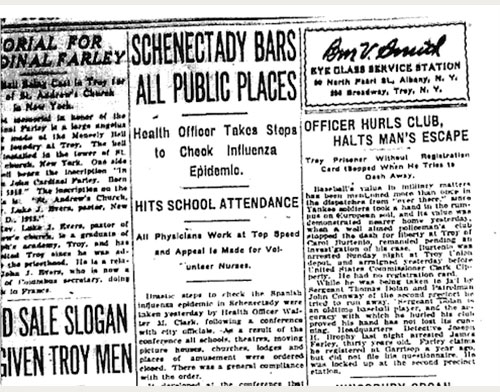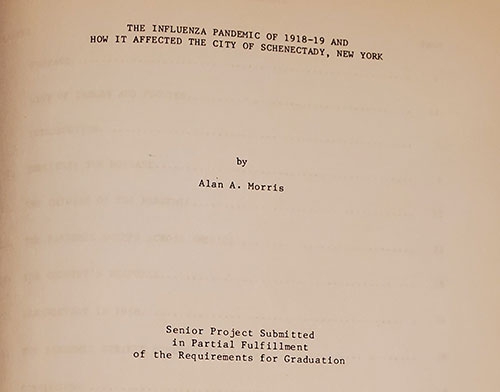At noon on Oct. 1, 1918, nearly 500 students (including some from Albany Medical College and Albany College of Pharmacy) gathered by the flagpole on campus to be inducted into the Students’ Army Training Corps (SATC). Created by the United States War Department, the makeshift program contracted with colleges across the country to use their facilities for officer training.
For the final two months of World War I, Union would transform from an academic to a military institution.
“Education as we knew it has been adjourned and so has that delightful thing we call college life,” the Union College Alumni Monthly noted.
Yet the war would not be the biggest threat faced by the College and its home city. Less than two weeks before the ceremony, Schenectady recorded its first death from an influenza epidemic that was racing around the globe. Arriving in three waves between the spring and winter, the numbers rose rapidly in fall and touched every neighborhood in the city. The virus crippled the workforce of two industrial giants, General Electric and the American Locomotive Company. Workers sprayed the downtown streets with disinfectant in a futile attempt to kill the virus.
Hospitals were overwhelmed treating the sick. Morgues filled to capacity with bodies. In October alone, the illness claimed a staggering 364 lives in Schenectady.
By the time the pandemic slowed in December, 404 people had died in Schenectady and another 15,000 were infected. Worldwide, the Spanish flu, as it was called, killed an estimated 50 million people, including 675,000 in the U.S. Remarkably, the deadliest pandemic in modern history claimed more victims than the total number of military and civilian deaths during World War I.
As Union carefully navigates the severe impact of the coronavirus, it is easy to see the similarities between today’s crisis and the 1918 pandemic.
In Schenectady at the time, churches, schools, libraries and theaters closed. Public health orders repeatedly warned residents not to loiter in restaurants and saloons, and to avoid crowded elevators and trolleys. The phrase “social distancing” did not exist but the idea was the same: slow the spread of the virus. Yet like today, some resisted. In an editorial in the Schenectady Gazette headlined “Do Your Share,” the newspaper urged the community to step up.
“It is not a case of a cold from bad weather, but a real epidemic that kills before its grip on a person is realized,” the editorial stated. “There will be heavy loss all around. That is inevitable. Business will suffer. That is but part of what we must pay for the plagues that fate sent our way.”
On campus, the 9:30 a.m. daily chapel services were suspended. Football games were canceled or postponed.
In September, the College had welcomed the largest freshman class in its history. This was due in part to the creation of the SATC, which provided tuition, a $30 monthly stipend, uniforms, equipment, quarters and rations for every candidate accepted.
As part of the war effort, the Army took over a number of campus buildings. The Delta Upsilon house (the current Lamont House) was converted to an infirmary because its architecture is “well adapted for hospital needs,” according to a 1918 story in the Concordiensis.
When the flu arrived, the infirmary stood prepared. Dr. Walter E. Goddard and his assistant, Dr. A.S. Fay, oversaw medical care. A nurse and six student volunteers in the pre-med program assisted. Four students worked the dayshift from 6 a.m. to 6 p.m., and two worked the nightshift. The infirmary treated an average of 15 patients a day.
By most accounts, the College was spared a ghastly death toll that overwhelmed other institutions where people lived in close quarters. The Encyclopedia of Union College History said the epidemic “struck many students, killing at least two,” though the precise number remains unclear.
“Dr. Goddard was not only efficient professionally, but he took hold of the work with enthusiasm and no small part of our good fortune during the influenza epidemic was due to his prompt organization of the infirmary and his care to isolate immediately and treat all suspected cases,” the Union College Alumni Monthly stated.
The Concordiensis also offered praise to the infirmary, writing, “A remarkable record was established here during the plague, there being but one death at the infirmary.”
Wolcott Calkins, a 19-year-old freshman and SATC member, became ill on Sunday, Oct. 20, 1918, while living in the Sigma Phi Club. The son of the mayor of Plainfield, N.J., Calkins died four days later in the infirmary, his family by his side.
At a service the next day at St. George’s Church in Schenectady, Calkins’s body was dressed in his military uniform, the coffin draped with the American flag. His fellow members of the SATC served as an honor guard.
A classmate, Everett Wemple ’22, died of the flu Jan. 18, 1919, but records do not indicate if he had been stricken with the Spanish flu. The names of Calkins and Wemple are among the 26 engraved on the wall in Memorial Chapel honoring those killed during World War I.
By early November, the epidemic in the city finally slowed. When the war ended on Nov. 11, however, there were large public celebrations downtown, triggering another batch of flu cases. By December, Schenectady recorded its final case.
Alan Morris ’86 wrote his senior thesis on the pandemic of 1918 and how it affected Schenectady. A copy is kept in the Schenectady Collection of the Schenectady County Public Library and available online through the Schenectady County Historical Society.
Morris, a podiatrist who majored in history and biology, he sees a host of parallels with the epidemic 102 years ago and COVID-19, in which there are more than a million cases worldwide so far and nearly 52,000 deaths. Among these are the government’s slow response when the virus first appeared, the aggressive public health orders to slow the spread and the escalating death rates.
This week, he pointed to his research of a meeting among top doctors at Ellis Hospital in early October 1918 as the Spanish flu made its early rounds. One of the doctors said he believed the epidemic had reached its zenith. Thousands were infected and hundreds died soon after.
“It’s almost exactly what we are seeing today,” said Morris. The former chief of the Division of Podiatry Surgery and the director of the Podiatry Clinic at Northwell Health’s Glen Cove Hospital, Morris has been in private practice since 1995.
“You need to take these viruses seriously and minimize their impact. You don’t know how they are going to behave, especially if they are a novel virus that we haven’t seen before.”
In addition to his knowledge of the 1918 pandemic, Morris has a personal connection to today’s epidemic. His wife, Lisa, is a physician’s assistant who was pressed into duty at a COVID-19 unit in a Long Island hospital.
Morris’s research in 1986 foreshadowed today’s crisis.
“Can a pandemic the magnitude of 1918 strike again?” he writes in his thesis. “One only has to look at the panic that took place amongst government agencies in 1976, when the country was threatened by the possibility of a Swine Flu epidemic to answer that question. People are frightened by influenza, partially because of our inability to control it.”


